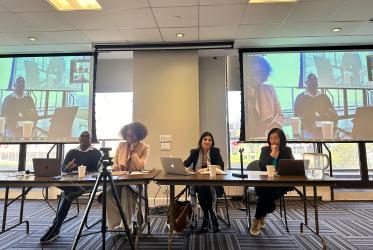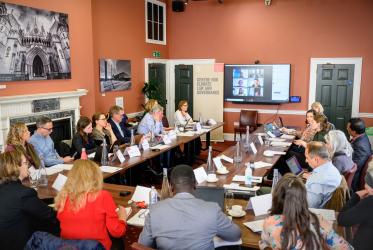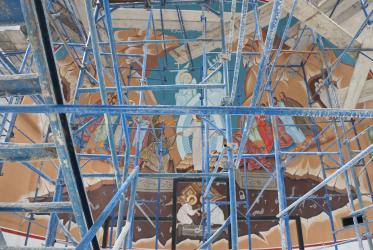Drilling and climate change threaten the future of Netro’s community, along with many others in the Arctic.
“How do we work together?” asks Netro, and answers with a clear message for the World Council of Churches (WCC) and others who reach out: "We need you as messengers for the well-being of our people. We need your voice.”
Netro was born and raised in Old Crow, where her mother introduced her to the traditional values of the Vuntut Gwich’in at a young age. Now an advocate for Arctic peoples on the strong foundation of Gwich’in culture, history, and traditions, she has served on the Porcupine Caribou Management Board and the Gwich’in Council International.
She has also made the three-day journey to Washington D.C. many times over the past 20 years, meeting with members of Congress to share her story and advocate for the protection of the Arctic Refuge. Netro is dedicated to making sure that her grandchildren, the entire Gwich’in Nation, and those not yet born will always have access to the same culture and traditions that shaped her life.
WCC pilgrim teams met, some in person and some online, with Netro as part of a series of visits in Arctic communities from 26-28 April. During 2021, the WCC Pilgrimage of Justice and Peace is focusing on North America.

The frontlines of climate change
The Arctic is one of the places where climate change hurts the most, tearing at the fabric of society for Alaskan native peoples, Inuit and Sami. The region is heating up twice as fast as the global average, leaving indigenous peoples facing threats of food insecurity due to declining animal and plant life, erosion of traditional livelihoods and ways of living, desecration of ancestral sites, and social and cultural dislocation.
Milder winters are leading to the decline of caribou and reindeer populations, for instance, and therefore the livelihoods of Gwich’in and Sami communities that depend on it.
Spanning parts of North America and Europe, the Arctic is rich in oil and mineral reserves. While the region’s isolation has offered some protection from rampant economic exploitation, the melting of sea ice poses a further risk – easier access to coveted resources. Even though most government figureheads in the region are indigenous, major decisions around resource use and extraction are being made in the world’s financial and corporate centres with little regard for local communities’ wellbeing and ecological consequences. A history of colonization has also left an enduring negative impact.
“Wind power development is a form of green colonizaton,” said Sara Ellen Anne Eira, a leader in the Sami Church Council. The wind industry is taking Sami lands, destroying reindeer grazing grounds and posing a “threat to the life and culture of the Samis.”
In a statement, the Sami Church Council reminded decisionmakers that governments have the responsibility to ensure that vulnerable groups are not subject to greater struggles than the rest of the society. “It is important that so-called solutions to the climate crisis do not harm indigenous peoples,” Eira shared.
The COVID-19 pandemic has also hit indigenous communities in the region hard. In some parts, infection and fatality rates are higher than average due to poor access to healthcare. And the impacts on the local economies have been devastating. Even before the pandemic, unemployment rates in these areas were already 2 or 3 times higher than during the Great Depression. Communities survive through hunting, herding, and fishing – ancient ways of living that are increasingly undermined by a warming climate.
“Being out on the land is meditation,” said Anne Keenainak, an Inuit and a graduate of the Arthur Turner Training School of the Diocese of the Arctic of the Anglican Church in Canada. The “knowledge of how to live together off the land” and the sharing of its fruits are key to the resilience of our Inuit communities, added Keenainak.
A critical mirror to the future
People concerned about the climate emergency are increasingly turning to indigenous Arctic wisdom because it offers alternative visions, spiritual resources, and concrete practices to mitigate, adapt and build resilience.
Archbishop Mark MacDonald, WCC president, national indigenous bishop, Anglican Church of Canada, who served as the host for the visits, said these pilgrimages were an important entry point to a reality that few people around the world understand, much less experience.
“This is unfortunate, since the Arctic is one of the most critical mirrors to our future as a planetary family,” he said. “The way indigenous rights, climate justice, and ecological wholeness are treated in the Arctic are the paradigm for the planet.”
Uniquely and severely threatened by climate disruption, the Arctic communities provide a prophetic and sacrificial witness to the truth of humanity’s living and inseparable relationship to rest of Creation. “The moral and spiritual truth of this relationship is a foundational aspect of Arctic life,” said MacDonald. “This we saw in a vivid and inspiring display.”
Learn more about the WCC's Pilgrimage of Justice and Peace
Youth amplify #NoDAPL movement in Standing Rock - WCC news release 22 April 2021







